Do you think the 80s/90s advertisement campaign for Sarson’s vinegar – “Don’t say vinegar, say Sarson’s” – ever worked?
Like: have you ever heard anybody ask you to “pass the Sarson’s”?
Dan Q
Do you think the 80s/90s advertisement campaign for Sarson’s vinegar – “Don’t say vinegar, say Sarson’s” – ever worked?
Like: have you ever heard anybody ask you to “pass the Sarson’s”?
I swear I’m onto something with this idea: Scottish-Mexican fusion cookery. Hear me out.
It started on the last day of our trip to the Edinburgh Fringe Festival in 2012 when, in an effort to use up our self-catering supplies, JTA suggested (he later claimed this should have been taken as a joke) haggis tacos. Ruth and I ate a whole bunch of them and they were great.
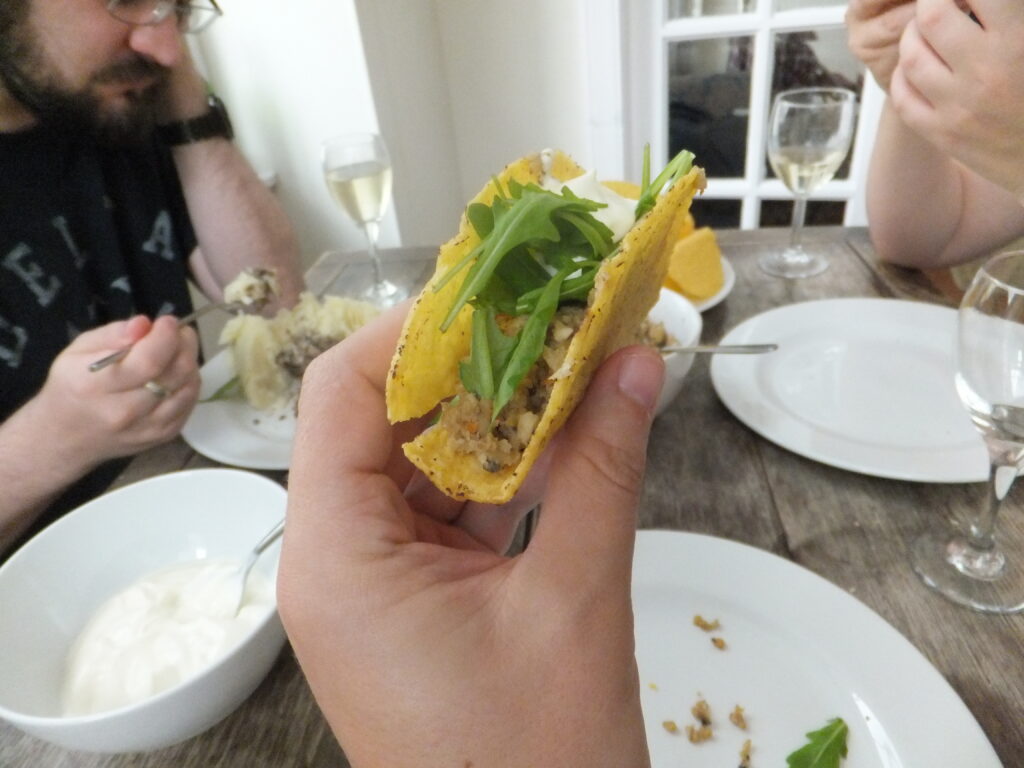
In Scotland last week (while I wasn’t climbing mountains and thinking of my father), Ruth and I came up with our second bit of Scottish-Mexican fusion food: tattie scone quesadillas. Just sandwich some cheese and anything else you like between tattie scones and gently fry in butter.
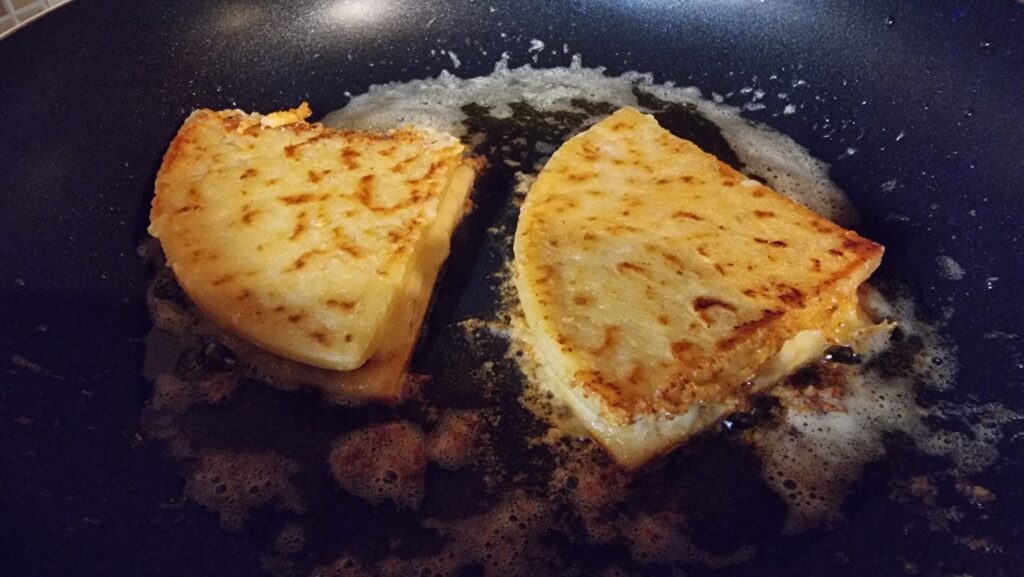
We’re definitely onto something. But what to try next? How about…
Earlier this month, I made my first attempt at cooking pizza in an outdoor wood-fired oven. I’ve been making pizza for years: how hard can it be?
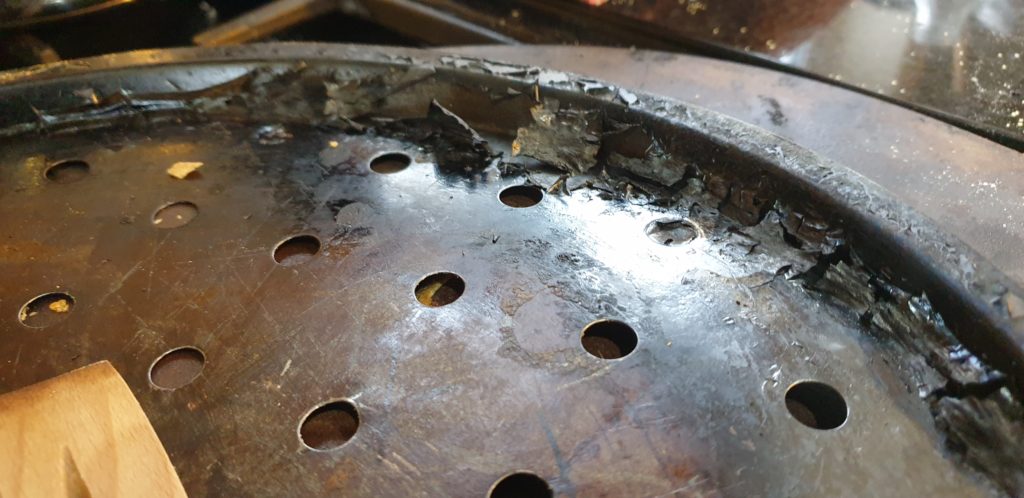
It turned out: pretty hard. The oven was way hotter than I’d appreciated and I burned a few crusts. My dough was too wet to slide nicely off my metal peel (my wooden peel disappeared, possibly during my house move last year), and my efforts to work-around this by transplanting cookware in and out of the oven quickly lead to flaming Teflon and a shattered pizza stone. I set up the oven outside the front door and spent all my time running between the kitchen (at the back of the house) and the front door, carrying hot tools, while hungry children snapped at my ankles. In short: mistakes were made.

I suspect that cooking pizza in a wood-fired oven is challenging in the same way that driving a steam locomotive is. I’ve not driven one, except in simulators, but it seems like you’ve got a lot of things to monitor at the same time. How fast am I going? How hot is the fire? How much fuel is in it? How much fuel is left? How fast is it burning through it? How far to the next station? How’s the water pressure? Oh fuck I forget to check on the fire while I was checking the speed…
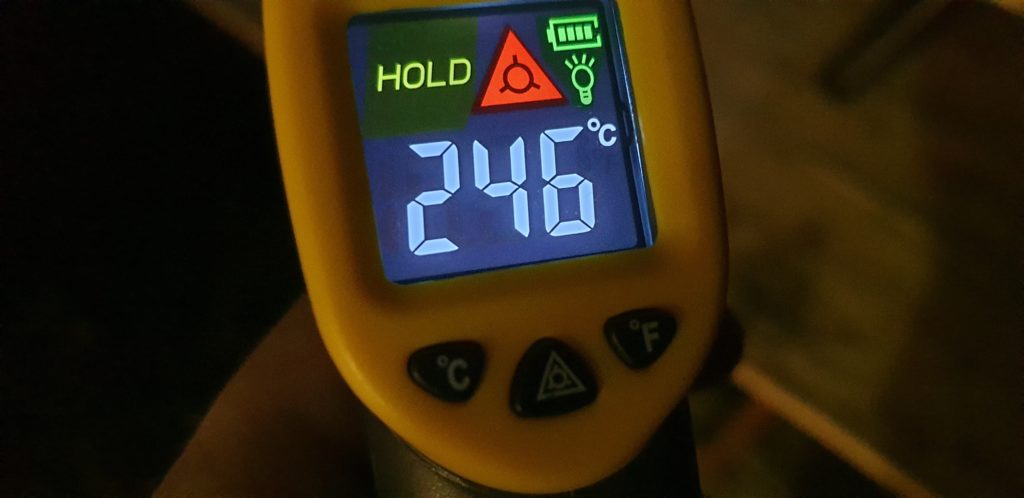
So it is with a wood-fired pizza oven. If you spend too long preparing a pizza, you’re not tending the fire. If you put more fuel on the fire, the temperature drops before it climbs again. If you run several pizzas through the oven back-to-back, you leech heat out of the stone (my oven’s not super-thick, so it only retains heat for about four consecutive pizzas then it needs a few minutes break to get back to an even temperature). If you put a pizza in and then go and prepare another, you’ve got to remember to come back 40 seconds later to turn the first pizza. Some day I’ll be able to manage all of those jobs alone, but for now I was glad to have a sous-chef to hand.
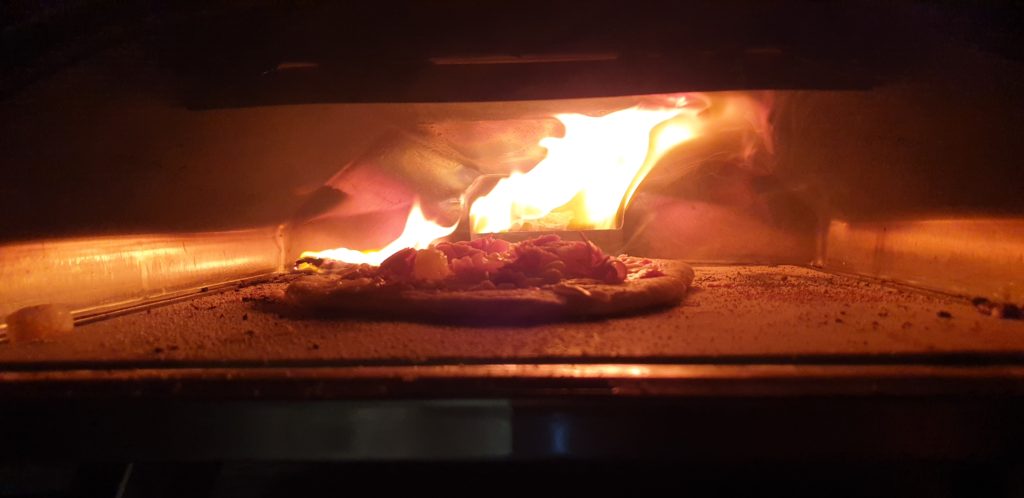
Today I was cooking out amongst the snow, in a gusty crosswind, and I learned something else new. Something that perhaps I should have thought of already: the angle of the pizza oven relative to the wind matters! As the cold wind picked up speed, its angle meant that it was blowing right across the air intake for my fire, and it was sucking all of the heat out of the back of the oven rather than feeding the flame and allowing the plasma and smoke to pass through the top of the oven. I rotated the pizza oven so that the air blew into rather than across the oven, but this fanned the flames and increased fuel consumption, so I needed to increase my refuelling rate… there are just so many variables!
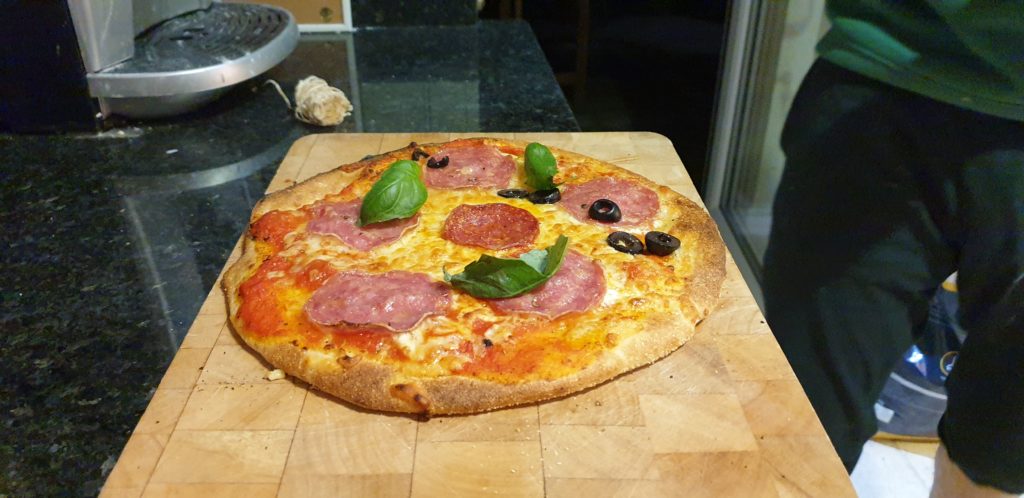
The worst moment of the evening was probably when I took a bite out of a pizza that, it turned out, I’d shunted too-deep into the oven and it had collided with the fire. How do I know? Because I bit into a large chunk of partially-burned wood. Not the kind of smoky flavour I was looking for.
But apart from that, tonight’s pizza-making was a success. Cooking in a sub-zero wind was hard, but with the help of my excellent sous-chef we churned out half a dozen good pizzas (and a handful of just-okay pizzas), and more importantly: I learned a lot about the art of cooking pizza in a box of full of burning wood. Nice.
Clearly those closest to me know me well, because for my birthday today I received a beautiful (portable: it packs into a bag!) wood-fired pizza oven, which I immediately assembled, test-fired, cleaned, and prepped with the intention of feeding everybody some homemade pizza using some of Robin‘s fabulous bread dough, this evening.
Fuelled up with wood pellets the oven was a doddle to light and bring up to temperature. It’s got a solid stone slab in the base which looked like it’d quickly become ideal for some fast-cooked, thin-based pizzas. I was feeling good about the whole thing.
But then it all began to go wrong.

If you’re going to slip pizzas onto hot stone – especially using a light, rich dough like this one – you really need a wooden peel. I own a wooden peel… somewhere: I haven’t seen it since I moved house last summer. I tried my aluminium peel, but it was too sticky, even with a dusting of semolina or a light layer of oil. This wasn’t going to work.
I’ve got some stone slabs I use for cooking fresh pizza in a conventional oven, so I figured I’d just preheat them, assemble pizzas directly on them, and shunt the slabs in. Easy as (pizza) pie, right?

This oven is hot. Seriously hot. Hot enough to cook the pizza while I turned my back to assemble the next one, sure. But also hot enough to crack apart my old pizza stone. Right down the middle. It normally never goes hotter than the 240ºC of my regular kitchen oven, but I figured that it’d cope with a hotter oven. Apparently not.
So I changed plan. I pulled out some old round metal trays and assembled the next pizza on one of those. I slid it into the oven and it began to cook: brilliant! But no sooner had I turned my back than… the non-stick coating on the tray caught fire! I didn’t even know that was a thing that could happen.

Those first two pizzas may have each cost me a piece of cookware, but they tasted absolutely brilliant. Slightly coarse, thick, yeasty dough, crisped up nicely and with a hint of woodsmoke.
But I’m not sure that the experience was worth destroying a stone slab and the coating of a metal tray, so I’ll be waiting until I’ve found (or replaced) my wooden peel before I tangle with this wonderful beast again. Lesson learned.
Noticing that our bagel supply was running low and with two kids who’d happily fight to the death for the last one if it came down to it, I decided this weekend to dust off an old recipe and restock using the ingredients in our cupboard. For a festive spin, I opted to make cranberry and cinnamon bagels, and served a few at my family’s regular Sunday brunch. Little did I know that they would turn out to be such a hit that not one from the resupply would survive to the end of the day, and I’ve been pressed into making them again in time for breakfast on Christmas Day (or, as Ruth suggested as she and Robin fought for the last one in a manner more-childish than the children ever would, I could “make them any time I feel like it; every week maybe?”).

If you’d like to make your own, and you totally should, the recipe’s below. I prefer volumetric measurements to weight for bread-making: if you’re not used to doing so, be sure to give your dry ingredients a stir/shake to help them settle when measuring.
Yield: 8 bagels
Duration:


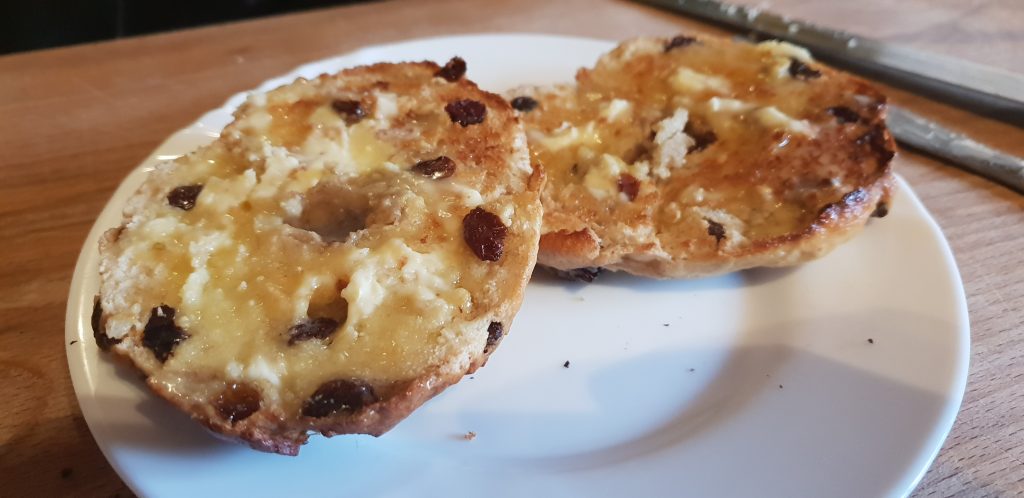
Mostly this recipe’s here for my own reference, but if you make some then let me know how they turn out for you. (Oh, and for those of you who prefer when my blog posts are technical, this page is marked up in h-recipe.)
This article is a repost promoting content originally published elsewhere. See more things Dan's reposted.
…
Set a timer. Cook the eggs for precisely three minutes and not a second longer.
Everyone thinks they have a sense of how time passes, but it’s crucial to use a timer. You are never as right as you think. Three minutes goes by more quickly than you expect. Six years even quicker.
…
Good instructions for poaching eggs. Also for leaving a marriage, for all I know. Surprisingly strong parallels between the two.
I normally reserve my “on this day” posts to look back at my own archived content, but once in a while I get a moment of nostalgia for something of somebody else’s that “fell off the web”. And so I bring you something you probably haven’t seen in over a decade: Paul and Jon‘s Birmingham Egg.

It was a simpler time: a time when YouTube was a new “fringe” site (which is probably why I don’t have a surviving copy of the original video) and not yet owned by Google, before Facebook was universally-available, and when original Web content remained decentralised (maybe we’re moving back in that direction, but I wouldn’t count on it…). And only a few days after issue 175 of the b3ta newsletter wrote:
* BIRMINGHAM EGG - Take 5 scotch eggs, cut in half and cover in masala sauce. Place in Balti dish and serve with naan and/or chips. We'll send a b3ta t-shirt to anyone who cooks this up, eats it and makes a lovely little photo log / write up of their adventure.

Clearly-inspired, Paul said “Guess what we’re doing on Sunday?” and sure enough, he delivered. On this day 13 years ago and with the help of Jon, Liz, Siân, and Andy R, Paul whipped up the dish and presented his findings to the Internet: the original page is long-gone, but I’ve resurrected it for posterity. I don’t know if he ever got his promised free t-shirt, but he earned it: the page went briefly viral and brought joy to the world before being forgotten the following week when we all started arguing about whether 9 Songs was a good film or not.
It was a simpler time, when, having fewer responsibilities, we were able to do things like this “for the lulz”. But more than that, it was still at the tail-end of the era in which individuals putting absurd shit online was still a legitimate art form on the Web. Somewhere along the way, the Web got serious and siloed. It’s not all a bad thing, but it does mean that we’re publishing less weirdness than we were back then.
This link was originally posted to /r/avapoet. See more things from Dan's
Reddit account.
The original link was:
http://www.informationisbeautiful.net/2015/oil-well-every-cooking-oil-compared/?utm_source=feedburner&utm_medium=feed&utm_campaign=Feed%3A+InformationIsBeautiful+%28Information+Is+Beautiful%29
I’m a big fan of pizza. I use it to celebrate people moving house back to Aber; I use it to bribe people to help me move house; I’ve been known to travel into the next country over in search of the “right” one; over the course of the 300 or so Troma Nights I hosted between 2004 and 2010, it got to the point that our local pizza place would bring our food in through the front door and directly to each consumer; and once we got as far south as Naples, finding the world’s best pizza was among the first things on Claire and I’s minds. I like pizza: you get the picture.
More-lately, I’m also a big fan of making pizza. I’ve always enjoyed making bread, but over the last five years or so I’ve become particularly fascinated with making pizzas. I make a pretty good one now, I think, although I’m still learning and periodically experimenting with different flour blends, cooking surfaces, kneading techniques and so on. Those of you who know how capable I am of being a giant nerd about things should understand what I mean when I say that I’ve gotten to be a pizza nerd.
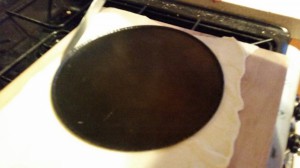
In pizza-related circles of the Internet (yes, these exist), there’s recently been some talk about pizza cake: a dish made by assembling several pizzas, stacked on top of one another in a cake tin – ideally one with a removable base – and then baking them together as a unit. Personally, I think that the name “pizza cake” isn’t as accurate nor descriptive as alternative names “pizza pie” (which unfortunately doesn’t translate so well over the Atlantic) or “pizza lasagne” (which is pretty universal). In any case, you can by now imagine what I’m talking about. What I’m talking about is an artery-destroying monster.

Not wanting to squander my dough-making skills on something that must be cut to size (proper pizza dough should always be stretched, or in the worst case rolled, to size – did I mention that I’d been getting picky about this kind of stuff?), I opted to go for the lazy approach and use some pre-made dough, from a chilled can. That was probably my first and largest mistake, but a close second was that I followed through with this crazy idea at all.
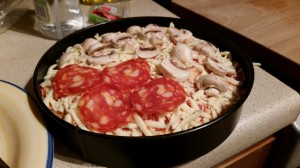
I didn’t have as deep a cake tin as I’d have liked, either, so my resulting pizza cake was shorter and squatter than I might have liked. Nonetheless, it came together reasonably well, albeit with some careful repositioning of the ingredients in order to provide the necessary structural support for each layer as it was added. I eventually built four layers: that is, from bottom to top – dough, tomato, cheese, pepperoni & mushrooms, dough, tomato, cheese, pepperoni & mushrooms, dough, tomato, cheese, pepperoni & mushrooms, dough, tomato, cheese, pepperoni & mushrooms. As I went along I found myself thinking about calzone.

Using a cake tin with a removable base turned out to be an incredibly wise move, as it proved possible to separate the food from its container by simply running around the outside and then tapping the tin from underneath. It had the weight and consistency of a cake of similar size, and smelled richly like freshly-based bread and cheese: exactly what you’d expect, really. I sliced it into six wedges, “cake-style”, and served it with a side salad to my courageous test pilots.
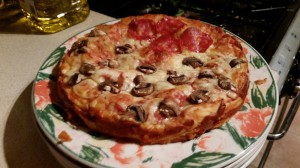
Ultimately, though, the experience wasn’t one we’re likely to repeat: the resulting dish was less-satisfying than if I’d just gone to the effort of making four regular pizzas in the first place. It was impossible to get an adequately crispy crust over the expanded surface area without risking burning the cheese, and as a result the central bread was unsatisfyingly stodgy, regardless of how thin I’d rolled it in anticipation of this risk. Having toppings spread through the dish was interesting, but didn’t add anything in particular that’s worthy of note. And while we ate it all up, we wouldn’t have chosen it instad of an actual pizza unless we’d never tried it before – once was enough.
But that’s just our experience: if you give pizza cake/pie/lasagne a go, let me know how you get on. Meanwhile, I’ll stick to making my own dough and using it to make my own regular, flat pizzas. The way that the pizza gods intended!
Three on the go at once; with moderate “flipping” success. Sometimes. Except for the one that gets stuck.
Note Matt‘s look of concentration: that’s an essential part of the process.
The hiss in the background in the extractor fan. Sorry about that.
This link was originally posted to /r/pics. See more things from Dan's Reddit account.
The original link was: http://i.imgur.com/93SYI.jpg
To those of you that don’t know already, I have a confession to make. After years of picking holes in and finding flaws in their various ethical or other arguments and of mocking their dietary choices, I’ve become… a vegetarian.

Okay, this probably wasn’t actually a shock to anybody. Between the observations of the barbeque food I’ve been enjoying recently and the fact that I willingly chose falafel over hog roast a month or so ago, it’s quite possible that you’re saying “well, duh” at this so-called revelation. That’s why I thought it’d be far more-interesting for me to talk about the principal reason for this change.
You don’t eat what, now?
For some, however, this change has been a gradual one, beginning with dropping beef from my diet in January, and other red meats in March (making me, technically-speaking, a lacto–ovo–melo–pollo–pescetarian, which is quite a mouthful). Poultry and fish disappeared from my diet in April and May.
For a brief stint, I tried to remove milk, too, aiming for ovo-vegetarianism, but it turns out that – while oatmilk is a perfectly reasonable alternative to the white stuff, and there are some great soya-based dairy-free deserts – there really are no adequate vegan substitutes for cheese… and I’m just not quite capable of coping without it.

Why, Dan? WHY?
My decision to adopt a vegetarian diet is based on a few different influences, but the principal one amongst these is one of environmentalism and sustainability. Over the last few years it’s become increasingly apparent to me that the Western Pattern Diet has a hugely damaging effect in the following areas:
In short, I could probably best be described as an economic environmentalist vegetarian: I’m concerned primarily with making sure that our agricultural practices are sustainable for the benefit of humans, whether currently existing or future. More on that, little doubt, in the Frequently Anticipated Questions, below.
So… how’re you finding it?
Man, I miss bacon.

Giving up beef, it turned out, was reasonably easy. Ditto lamb. But bacon: that’s something I miss. When my co-worker Liz had a bacon, mushroom and cheese jacket potato at an office lunch the other week, I could have almost drowned in my own drool. I find myself envying those vegetarians I know who don’t eat meat because they don’t like it: those guys have it so easy…
Chicken’s been challenging, too, because it’s always been a go-to base ingredient for me, and I’ve had to learn to substitute other sources of protein into my diet. Thankfully, I’ve been in a strong position: many years of cooking for vegetarians, at one point or another, has given me a pretty good understanding of what’s good for what and a decent repertoire of already-vegetarian dishes.
I tried to give up milk and milk products after realising that the ecological impact of milk production – while significantly less than beef, for a variety reasons – is still higher than I’d like. Sadly, it turns out that milk turns up in just about everything, and cheese and cream are remarkably hard to do without. Maybe some day I’ll give that another go.
On the up-side, though, I’ve discovered a reasonable number of things that I didn’t think I liked, that actually I do… or at least, that are perfectly adequate substitutes for meat products.
But man, I miss bacon. Pigs may be clever, but they’re not smart enough to not be delicious.
I also routinely slip up on the likes of isinglass (used in the production of many of my favourite beers), and gelatine (which appears in a surprising number of things), and I try not to kick up a fuss where food is being prepared for several people, of which I’m only one, in a non-compatible way. For example, I tolerate the addition of Worcester sauce (containing anchovies) as an ingredient where a meal is being prepared for several people – it’d be incredibly inconvenient to require a separation of the food at this point during cooking, and I’m happy to compromise a little where the chef’s convenience collides with my ethics.
Frequently Anticipated Questions
In order that I jump the gun and answer you before you ask:
You consume products made using isinglass, gelatine, and occasional small quantities of fish sauce… you’re not a vegetarian at all!
I guess not. But the label’s for my convenience, not yours. I use the word vegetarian because it’s the simplest-common-denominator. If I ask in a restaurant “what have you got that’s vegetarian, or would be but that it contains trace amounts of isinglass, is made using gelatine, has Worcester sauce in, etc.” I’d never get my meal. Plus, the staff would be confused. To take a mathematical model: the set of things that better-vegetarians-than-I eat is completely contained within the set of things that I eat, and the two are very nearly the same, so to call myself a vegetarian is closer to a convenient rounding error than a lie.
Also; that wasn’t a question.
Do you expect to make a significant difference?
No. But, like many moral decisions, this isn’t about making a significant difference but about doing the right thing.
If there’s a riot in your town and an out-of-control crowd begins damaging and looting the shops in the high street, you might be tempted to go out and steal a nice laptop or television yourself, too. Regardless of whether or not you do so, you won’t make a significant difference – Currys will be just as empty in the morning whether you partake of a little ransacking or not. But that doesn’t change the fact that it would be wrong of you to rob them.
On the other hand, over the course of the rest of my life I’m liable, under ideal circumstances, to make a miniscule but measurable net decrease in the demand for meat products, which might, under ideal circumstances, have an impact on meat production, thereby coming some way to achieving my ideals. Moreover, I’d like to think that my dietary choices go some way to making those dietary choices more palatable (hah!) for others, which may influence others to reduce their meat consumption too.
If the aim is to reduce meat consumption, why not simply eat less meat?
Because I can’t trust everybody else to play along.
My gut feeling is that this would work (although I haven’t read any research to either confirm or deny that suspicion): that if we all just cut down our meat consumption so that we were eating meat only once every few weeks, that we’d have a huge impact on sustainability for the future. But I can’t make everybody do this. The best I can do is to do so myself.
However, if I go just a little bit further and stop eating meat altogether, then I also help to “make up” for other people’s meat-heavy diets.
For every animal you don’t eat, I’m going to eat two!
Well, I hope you enjoy it, because you’ll probably not live too long after consuming all the saturated fats of all of the animals I don’t eat.
In any case: I’m not responsible for how you choose to live your life, even if you are threatening to push Comic Book Guy off a railway overpass.
You mentioned that the economic/ecological reasons were the principal cause for your vegetarianism. Are there other reasons, too, like the health and longevity benefits or the cost saving?
Yes. But they’re not the principal reasons.
Incidentally, removing meat from my diet made it far easier for me to lose the second of my three 10kg weight loss goals (as part of my ongoing effort to get down from 110kg to 80kg; I’m currently at about 89kg), because it’s far easier to avoid fats when you’re already avoiding meat.
How does JTA feel, being the only non-vegetarian in the house?
He’s not… so much. These days, Ruth eats a reasonable amount of a select few different varieties of meat, and Paul… well, I’m not sure I can keep up with our favourite pepperoni-eating vegetarian, but I think that right now he’s abstaining from meat entirely, but I’m not sure.
I have a hypothesis that perhaps the world can only tolerate a certain number of vegetarians at once, so as I became one, Ruth had to stop.
What about sustainably-farmed fish/synthetic meat/a survival situation/some other hypothetical situation?
I’m pragmatic, first and foremost, so if somebody wants to demonstrate that a particular farmed fish is environmentally sound, to my satisfaction, then great: it’s back on the menu! I’m not going out of my way to look for any, though, because I was never a big seafood fan to begin with! It’s not a high priority for me to make my life more complicated by coming up with some kind of complex list of what’s okay and what’s not, when the simple rule “no meat” seems to be perfectly workable.
Survival situation: sure, I’d chow down on whatever was available to stay alive. I’m not stupid!
And synthetic meat? If it was economically-sound, environmentally-friendly, safe, and tasty… sounds like a win to me. Fetch me a plate!
Isn’t this quite a turnaround for somebody who was once quoted on the BBC as describing vegetarianism as an “eating disorder”?
Yes, I suppose it is. I’ve always prided myself, though, on what I call “correctness over consistency”: that is, I’d like to think that I’m able to do the right thing, even where it means contradicting my previous attitudes or behaviour. I believe that we’d all do a lot better if people were less attached than they are, on average, to appearing consistent, especially when they’re faced with new information. There’s no shame in saying “I was wrong then,” so long as you can show that you’re learning.
But yes, I’ve been quite mean to many vegetarians for many years, as if I needed reminding. And so yes, this really is quite a turnaround. And I’m proud to be capable of that.
References
Many of you reading this will have eaten one of my chilli con carnes before, where I’ve used my Da Bomb: The Final Answer hot sauce in the recipe before (original recipe). For those not in-the-know, when cooking chilli to feed four or so, I tend to use the following system to measure the hot sauce:
1. Dip last centimetre or two of a strand of spaghetti into sauce bottle.
2. Wipe excess sauce off back into bottle.
3. Dip spaghetti strand into chilli pan, then dispose of.
And this makes a nice, weighty, fruity (it’s not all about heat, y’know), strong chilli. It’s a powerful little sauce.
Anyway, while cooking this evening, I noticed that my upper lip was starting to go numb. This is normally a bad sign, indicative of having spilt an untraceable quantity of The Final Answer (dubbed who dares burns) on my fingers and then accidently having touched my face. I recall the time I hadn’t washed my hands quite well enough before going to bed with Claire, and you should have heard her scream…
…I digress. The stinging spread to my cheeks and got worse, and it took me some time to realise that what was causing this pain was, in fact, merely the habanero-infused steam ascending from my pans. Yes; the capsaicin quantity of this steam alone was enough to cause pain. This was where I became a little alarmed, and opened the window.
Surprisingly, this chilli is really quite mild… but I think I’ve come up with a recipe that makes toxic chilli-fied steam while it cooks, which is in it self remarkable. Now if only I can find a way to condense the steam and collect it into gas grenades…